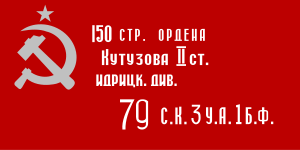Victory Banner (Soviet Union)

The Soviet/Russian Victory Banner ([Знамя Победы, Znamya Pobedy] Error: {{Lang-xx}}: text has italic markup (help)) is the banner that was raised by Red Army soldiers on the Reichstag in Berlin, in 1945. The Cyrillic inscription reads:
150th Rifle, Order of Kutuzov 2nd class, 'Idritskaya' Division, 79th Rifle Corps, 3rd Shock Army, 1st Byelorussian Front.
This flag is not the first to be hoisted on the Reichstag, but is the first (and the only surviving) of the 'official' flags, explicitly prepared for that purpose, to be raised there. During the Victory Day parade in Moscow on May 9, a copy of Victory Banner #5 is carried immediately behind the flag of the Russian Federation by members of the Presidential Guard.
Yeltsin's Victory Banner

There was a variation of the Soviet flag, without the hammer and sickle, to which president Boris Yeltsin gave a status similar to that of the national flag, on April 5, 1996. President Vladimir Putin also adopted the Victory Banner as the official flag of the Russian Army. This flag was named after the flag raised on the Reichstag, but it is also called Victory Flag.
Today this variation is no longer an official symbol. The Russian Ground Forces flag was once again changed to a flag without the soviet-era star[1][2].
The flags to be used for celebrations of the soviet Victory Day were defined by a federal law.[3]
